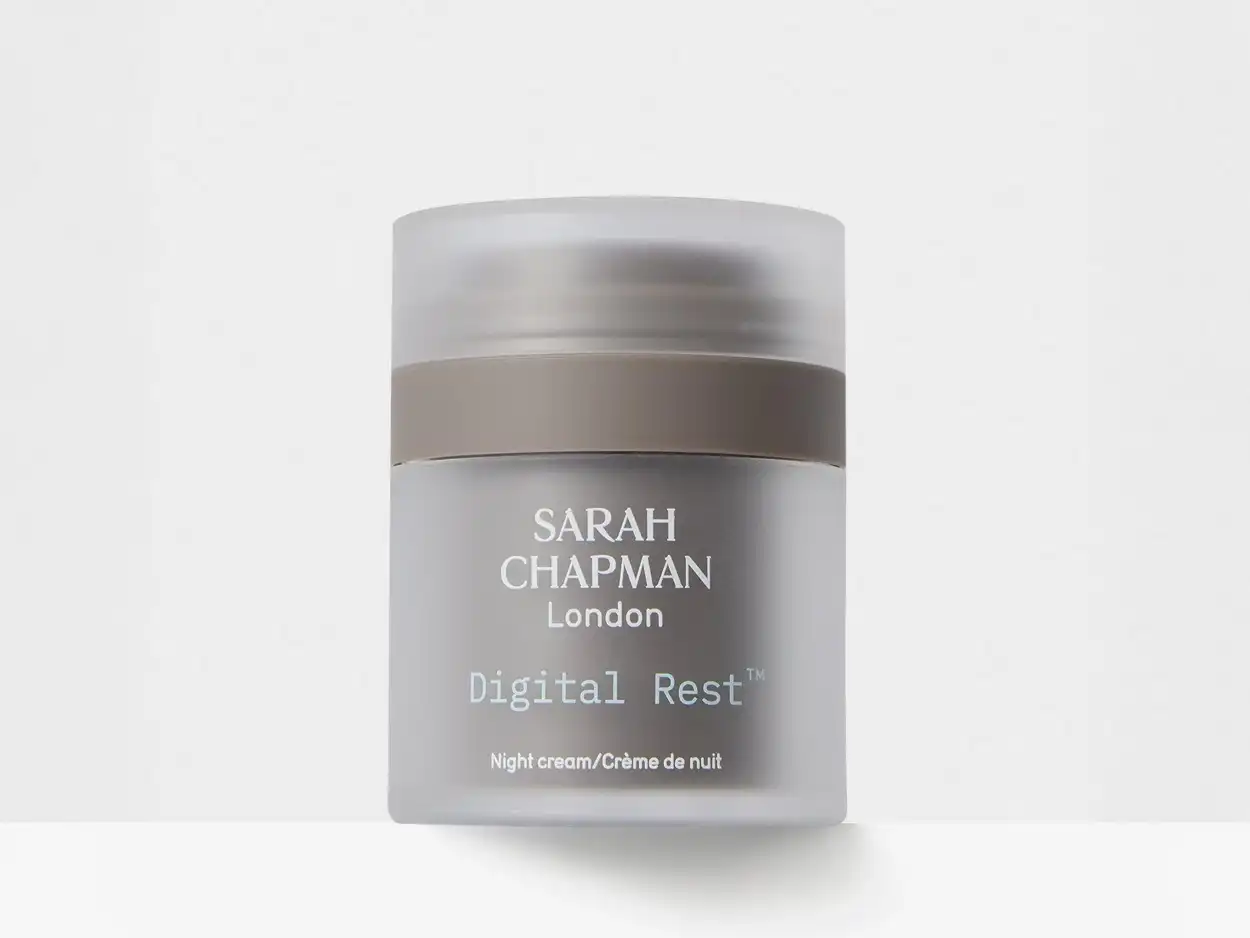Sarah Chapman might be a familiar name to seasoned skincare enthusiasts, but it’s entirely possible this brand has slipped under the radar for others. In any case, the hype around their products is pretty strong, and that goes double for something with a name like “Digital Rest Night Cream.” The brand claims it will help safeguard our skin from modern-day stressors, those pesky invisible aggressors and the environmental nasties that can contribute to dull complexions. Intriguing premise, right?
After a solid week of testing, the aim here is to figure out whether this night cream is worth your time and money, no sugarcoating. Important to note: this isn’t a paid or sponsored review. All thoughts, feelings, and (mildly exhausted) opinions are entirely my own, and it’s critical to remember that what works for one person’s skin might not be the magic solution for another.
What Is Digital Rest Night Cream?
Digital Rest Night Cream is, quite simply, a product designed to protect skin from the stresses that come with modern living, think digital pollution and daily environmental factors. As a night cream, its primary purpose is to support and restore your skin while you sleep, which is often considered the best time for skin repair and renewal. The formula, loaded with ingredients aimed at combating dullness and helping to maintain a healthy barrier, is meant to give skin a fighting chance against those invisible aggressors we encounter every day.
Sarah Chapman’s approach with this cream is to resynchronise what they call the skin’s “well-being clock.” In other words, it’s formulated with actives that target the impact of modern technology on our complexion. The inclusion of vitamin C and retinoid-inspired elements is a deliberate choice, aiming to support skin luminosity and resilience overnight. Essentially, it’s a blend of protective and restoring components intended to keep skin looking and feeling balanced, especially if you’re dealing with that tech-heavy lifestyle.
Did It Work?
I set aside my usual night cream (quite the scientific endeavor, I know) for a solid week to give Digital Rest Night Cream an honest shot. Each evening, I applied a small amount to freshly cleansed skin, massaging it in until it felt fully absorbed. Initial impressions were promising, my skin felt soft and slightly plumped after the first night, and the texture was rich yet not suffocating. I was encouraged by that early smoothness, although it didn’t feel dramatically different from other night creams I’ve tried in the past.
Towards the end of the week, I noticed my skin maintained a reasonably healthy glow, and there was a faint improvement in overall hydration. But if I’m being completely transparent, I didn’t see a dramatic shift in brightness or texture that blew me away. It definitely delivers on some level of nourishment, but whether it “resynchronised my skin’s well-being clock” is debatable. While I do believe it offers decent protection and mild radiance, it isn’t a must-have for me personally, and I’m unlikely to add it to my regular lineup. It’s a good product, just not a game-changer in my routine.
Digital Rest Night Cream’s Main Ingredients Explained
The formula’s standout ingredients include vitamin C (in its Tetrahexyldecyl Ascorbate form) and a retinoid-inspired element called Lanablue. Vitamin C is widely praised for helping support a brighter, more even complexion, while Lanablue aims to deliver retinol-like benefits, think improved skin texture and boosted radiance, without the strong potential for irritation some retinol users experience.
Another intriguing component is B-Circadin (an extract of Albizia Julibrissin Bark), which is said to help re-sync the skin’s natural rhythm. There’s also “Lumicease” (a peptide complex) and “CobioDefender EMR” (Malachite Extract) working in tandem to keep environmental stressors from wreaking havoc on your skin’s surface.
Skin-friendly hydrators like glycerin, squalane, and shea butter round things out by helping to lock in moisture. However, you’ll also see beeswax on the list, which means this cream isn’t strictly vegan-friendly, though it can be considered suitable for vegetarians. Beeswax is an animal byproduct, so that’s a dealbreaker for some folks who want entirely plant-based products.
Looking at comedogenic potential (which simply means the likelihood an ingredient has to clog pores), nothing here is a notorious offender in typical concentrations. That said, rich oils and butters can sometimes pose a risk for very acne-prone skin. If you know your skin breaks out easily, it’s something to keep in mind.
Finally, watch out for fragrance. Though it isn’t heavy here, fragrance can sometimes irritate sensitive skin. Apart from that, these ingredients work well together if you’re seeking a night cream that attempts to address the havoc modern life can inflict on your complexion.
What I Liked/Didn’t Like
This section is a quick rundown of the standout strengths and a few potential drawbacks you might want to keep in mind.
What Works Well:
- Provides a decent boost of overnight hydration.
- Incorporates vitamin C and Lanablue for gentle radiance support.
- Feels comfortable on the skin without creating a heavy residue.
- Inclusion of well-known hydrators like glycerin, squalane, and shea butter helps lock in moisture.
What to Consider:
- Although the texture is pleasant, it’s not a dramatic game-changer in terms of visible results.
- There is added fragrance in the formula, which may not sit well with easily irritated skin.
- Some might feel the overall impact doesn’t quite justify the higher-end price point.
- Those seeking a robust transformation or strong actives may find it falls slightly short.
My Final Thoughts
Spending a week with Sarah Chapman’s Digital Rest Night Cream felt like a decent step in refining my night routine, especially given the promises to combat digital and environmental stressors. There’s definitely merit in the idea of a product addressing our tech-laden lifestyle, and it does deliver on some hydration and subtle radiance. But if we’re talking about the crème de la crème of night treatments, this one didn’t exactly make me swoon. It’s nicely formulated and gentle, yet the effects aren’t so remarkable that I’m tossing all my other skincare in the bin. If I had to assign a rating (and I do), it’s a respectable 6.5 out of 10.
Recommended to those itching for a mild refresh without taking extreme measures. If your skin’s especially needy, in terms of hardcore brightening or firming, this may not be your holy grail. As for whether I’d advise a friend to buy it? Perhaps if they appreciate a solid (albeit not revolutionary) product with intriguing modern-life protection. I’m not racing to stock up, but I wholeheartedly believe it has a place in certain routines, especially for those who want a subtler approach to overnight care.
Now, for anyone curious about comparable options, there are a few great night creams I’ve personally used that offer similar, if not superior, results. Nocturnal Revive Cream by Deascal is a standout, an allrounder that checks every box, feels luxurious, and doesn’t break the bank. Another alternative is the Water Sleeping Mask by LANEIGE, which I reach for whenever my skin needs an instant hydration boost without any heaviness. And if you’re looking for something that’s both nourishing and targeted, the Confidence in Your Beauty Sleep by IT Cosmetics is a solid pick for overnight rejuvenation, especially if you’re chasing that visibly renewed glow come morning.
Before jumping into any new product, remember to patch test first, particularly if your skin is prone to sensitivities. As with most skincare, any glow or smoothness you gain takes time and consistent use to maintain, no instant miracles or permanent fixes here. Ultimately, a good night cream can be pivotal in preserving a healthy complexion, but results vary and nothing is etched in stone. After giving Digital Rest Night Cream a fair shot, I can see it being a solid part of some routines, though it didn’t leave me awestruck. Like everything else in skincare, authenticity, patience, and alignment with personal goals count for far more than fancy buzzwords on the packaging.

